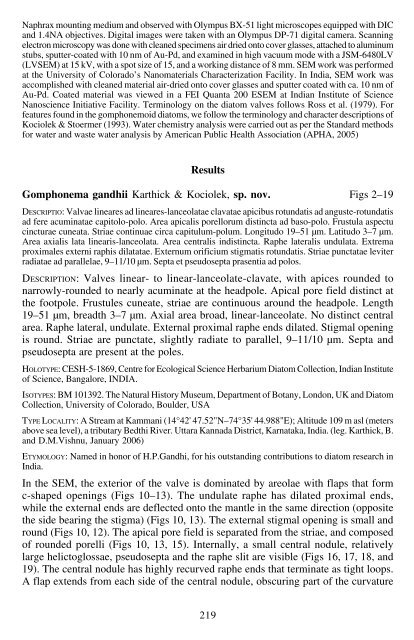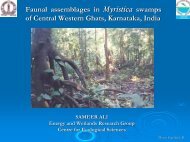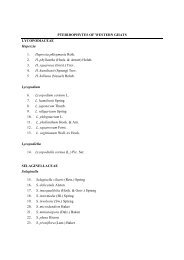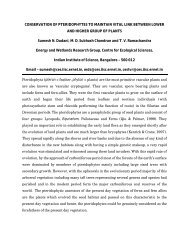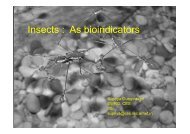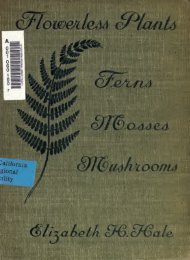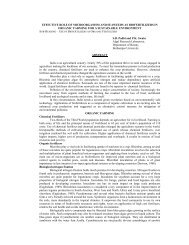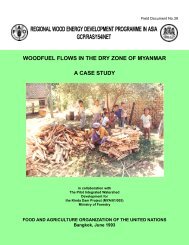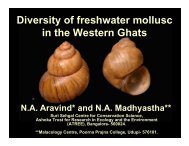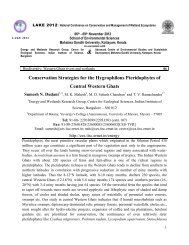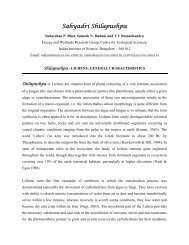The diatom genus Gomphonema Ehrenberg in India: Checklist and ...
The diatom genus Gomphonema Ehrenberg in India: Checklist and ...
The diatom genus Gomphonema Ehrenberg in India: Checklist and ...
You also want an ePaper? Increase the reach of your titles
YUMPU automatically turns print PDFs into web optimized ePapers that Google loves.
Naphrax mount<strong>in</strong>g medium <strong>and</strong> observed with Olympus BX-51 light microscopes equipped with DIC<br />
<strong>and</strong> 1.4NA objectives. Digital images were taken with an Olympus DP-71 digital camera. Scann<strong>in</strong>g<br />
electron microscopy was done with cleaned specimens air dried onto cover glasses, attached to alum<strong>in</strong>um<br />
stubs, sputter-coated with 10 nm of Au-Pd, <strong>and</strong> exam<strong>in</strong>ed <strong>in</strong> high vacuum mode with a JSM-6480LV<br />
(LVSEM) at 15 kV, with a spot size of 15, <strong>and</strong> a work<strong>in</strong>g distance of 8 mm. SEM work was performed<br />
at the University of Colorado’s Nanomaterials Characterization Facility. In <strong>India</strong>, SEM work was<br />
accomplished with cleaned material air-dried onto cover glasses <strong>and</strong> sputter coated with ca. 10 nm of<br />
Au-Pd. Coated material was viewed <strong>in</strong> a FEI Quanta 200 ESEM at <strong>India</strong>n Institute of Science<br />
Nanoscience Initiative Facility. Term<strong>in</strong>ology on the <strong>diatom</strong> valves follows Ross et al. (1979). For<br />
features found <strong>in</strong> the gomphonemoid <strong>diatom</strong>s, we follow the term<strong>in</strong>ology <strong>and</strong> character descriptions of<br />
Kociolek & Stoermer (1993). Water chemistry analysis were carried out as per the St<strong>and</strong>ard methods<br />
for water <strong>and</strong> waste water analysis by American Public Health Association (APHA, 2005)<br />
Results<br />
<strong>Gomphonema</strong> g<strong>and</strong>hii Karthick & Kociolek, sp. nov. Figs 2–19<br />
DESCRIPTIO: Valvae l<strong>in</strong>eares ad l<strong>in</strong>eares-lanceolatae clavatae apicibus rotundatis ad anguste-rotundatis<br />
ad fere acum<strong>in</strong>atae capitolo-polo. Area apicalis porellorum dist<strong>in</strong>cta ad baso-polo. Frustula aspectu<br />
c<strong>in</strong>cturae cuneata. Striae cont<strong>in</strong>uae circa capitulum-polum. Longitudo 19–51 µm. Latitudo 3–7 µm.<br />
Area axialis lata l<strong>in</strong>earis-lanceolata. Area centralis <strong>in</strong>dist<strong>in</strong>cta. Raphe lateralis undulata. Extrema<br />
proximales externi raphis dilatatae. Externum orificium stigmatis rotundatis. Striae punctatae leviter<br />
radiatae ad parallelae, 9–11/10 µm. Septa et pseudosepta prasentia ad polos.<br />
DESCRIPTION: Valves l<strong>in</strong>ear- to l<strong>in</strong>ear-lanceolate-clavate, with apices rounded to<br />
narrowly-rounded to nearly acum<strong>in</strong>ate at the headpole. Apical pore field dist<strong>in</strong>ct at<br />
the footpole. Frustules cuneate, striae are cont<strong>in</strong>uous around the headpole. Length<br />
19–51 µm, breadth 3–7 µm. Axial area broad, l<strong>in</strong>ear-lanceolate. No dist<strong>in</strong>ct central<br />
area. Raphe lateral, undulate. External proximal raphe ends dilated. Stigmal open<strong>in</strong>g<br />
is round. Striae are punctate, slightly radiate to parallel, 9–11/10 µm. Septa <strong>and</strong><br />
pseudosepta are present at the poles.<br />
HOLOTYPE: CESH-5-1869, Centre for Ecological Science Herbarium Diatom Collection, <strong>India</strong>n Institute<br />
of Science, Bangalore, INDIA.<br />
ISOTYPES: BM 101392. <strong>The</strong> Natural History Museum, Department of Botany, London, UK <strong>and</strong> Diatom<br />
Collection, University of Colorado, Boulder, USA<br />
TYPE LOCALITY: A Stream at Kammani (14°42' 47.52"N–74°35' 44.988"E); Altitude 109 m asl (meters<br />
above sea level), a tributary Bedthi River. Uttara Kannada District, Karnataka, <strong>India</strong>. (leg. Karthick, B.<br />
<strong>and</strong> D.M.Vishnu, January 2006)<br />
ETYMOLOGY: Named <strong>in</strong> honor of H.P.G<strong>and</strong>hi, for his outst<strong>and</strong><strong>in</strong>g contributions to <strong>diatom</strong> research <strong>in</strong><br />
<strong>India</strong>.<br />
In the SEM, the exterior of the valve is dom<strong>in</strong>ated by areolae with flaps that form<br />
c-shaped open<strong>in</strong>gs (Figs 10–13). <strong>The</strong> undulate raphe has dilated proximal ends,<br />
while the external ends are deflected onto the mantle <strong>in</strong> the same direction (opposite<br />
the side bear<strong>in</strong>g the stigma) (Figs 10, 13). <strong>The</strong> external stigmal open<strong>in</strong>g is small <strong>and</strong><br />
round (Figs 10, 12). <strong>The</strong> apical pore field is separated from the striae, <strong>and</strong> composed<br />
of rounded porelli (Figs 10, 13, 15). Internally, a small central nodule, relatively<br />
large helictoglossae, pseudosepta <strong>and</strong> the raphe slit are visible (Figs 16, 17, 18, <strong>and</strong><br />
19). <strong>The</strong> central nodule has highly recurved raphe ends that term<strong>in</strong>ate as tight loops.<br />
A flap extends from each side of the central nodule, obscur<strong>in</strong>g part of the curvature<br />
219


